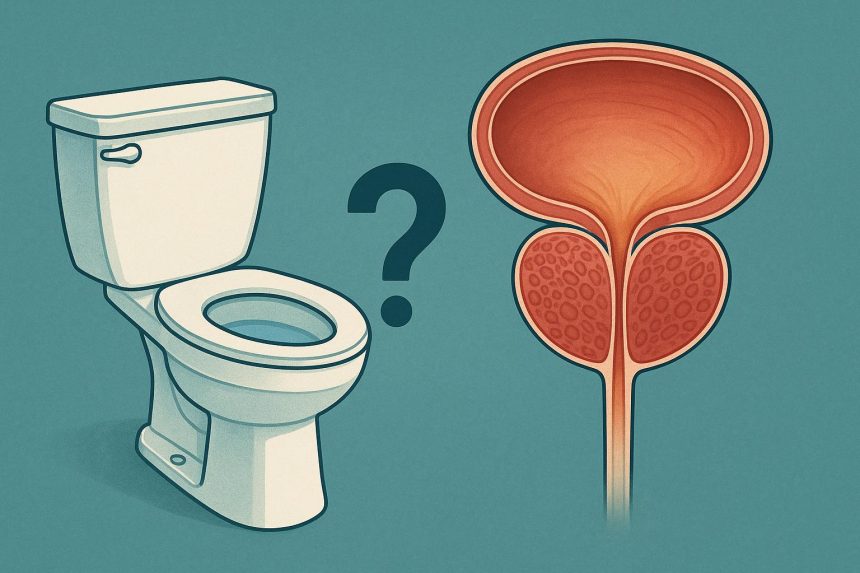Introduction
Do you know that your bladder can hold up to 600ml of urine but triggers the urge to urinate at just 150–200ml? Frequent urination disrupts daily activities and sleep when you find yourself visiting the bathroom more than eight times during waking hours or multiple times at night. While benign prostatic hyperplasia (BPH) causes this symptom in many men over 50, several other conditions produce similar urinary patterns. The prostate gland surrounds the urethra like a donut around a straw — when it enlarges, it squeezes this passage and affects urine flow. However, urinary tract infections, diabetes, overactive bladder syndrome, and certain medications can create identical symptoms through different mechanisms.
Distinguishing between these causes requires examining accompanying symptoms, timing patterns, and characteristics of urinary changes with a healthcare professional. If you’re experiencing persistent urinary issues, consulting a qualified urology specialist in Singapore can help determine the exact cause and provide tailored treatment options.
Benign Prostatic Hyperplasia (BPH) and Urinary Symptoms
The prostate gland typically measures about 20–25 grams in younger men but can grow to 40–100 grams or larger with BPH. This growth compresses the urethra and triggers the bladder muscle to work harder, leading to characteristic symptoms beyond just frequency.
Men with BPH experience a weak urine stream that may start and stop involuntarily. The stream often begins slowly after standing at the toilet for several seconds, a delay called hesitancy. Individuals might strain to empty the bladder completely, yet feel the need to urinate again within minutes. Dribbling after urination leaves underwear damp despite careful shaking.
Nocturia — waking to urinate at night — particularly disrupts sleep quality. BPH often causes multiple nighttime trips. The International Prostate Symptom Score (IPSS) helps quantify these symptoms: scores above 8 indicate moderate symptoms, while scores above 20 suggest severe BPH that may require medical evaluation.
BPH develops gradually over years. The transitional zone of the prostate grows inward, creating nodules that compress surrounding tissue. Unlike prostate cancer, which typically grows in the peripheral zone, BPH remains benign but significantly impacts quality of life. Digital rectal examination reveals a smoothly enlarged, rubbery prostate without the hard nodules associated with cancer.
Urinary Tract Infections
UTIs cause sudden-onset frequent urination accompanied by burning sensations during urination (dysuria). The urine appears cloudy, sometimes pink or cola-colored from blood, and emits a strong, unpleasant odor. Lower abdominal pain and pelvic pressure distinguish UTIs from prostate problems.
Bacteria, typically E. coli from the intestinal tract, travel up the urethra into the bladder. Men’s longer urethras provide natural protection, making UTIs less common than in women. When UTIs occur in men, they often indicate an underlying issue like incomplete bladder emptying from BPH, kidney stones, or catheter use.
Fever above 38°C, chills, and back pain suggest the infection has reached the kidneys (pyelonephritis), requiring immediate medical attention. Urine cultures identify the specific bacteria and guide antibiotic selection.
Diabetes and Polyuria
Elevated blood glucose levels above 180 mg/dL overwhelm the kidneys’ reabsorption capacity, causing glucose to spill into urine. Glucose draws water through osmosis, increasing urine volume — a process called osmotic diuresis. People with diabetes may produce large volumes of pale, dilute urine compared to normal amounts.
This excessive urination (polyuria) differs from the frequent small-volume urination of BPH. Increased thirst (polydipsia) accompanies the fluid loss, creating a cycle of drinking and urinating that continues through the night.
Overactive Bladder Syndrome
Overactive bladder (OAB) causes sudden, intense urges to urinate that are difficult to postpone. These urges occur even when the bladder contains only small amounts of urine. The detrusor muscle contracts inappropriately, creating false signals of fullness.
OAB symptoms include frequent urination and urge incontinence — involuntary urine loss following sudden urges. Unlike BPH, OAB doesn’t cause hesitancy, weak stream, or incomplete emptying.
Behavioral modifications and bladder training are often first-line treatments. When lifestyle adjustments aren’t enough, medications such as oxybutynin or mirabegron may help calm bladder contractions under the guidance of a urology specialist.
Medication-Induced Urinary Changes
Some medications, such as diuretics, intentionally increase urine production to manage hypertension or heart failure. Antidepressants, antipsychotics, and Parkinson’s drugs can also alter bladder function and cause urinary frequency. Caffeine and alcohol act as natural diuretics and bladder irritants, so reducing these may help improve symptoms.
💡 Did You Know?
The bladder’s inner lining contains specialized umbrella cells that stretch to accommodate urine without allowing leaks into surrounding tissues.
Diagnostic Approach
A urology specialist in Singapore will evaluate frequent urination through a detailed medical history, physical examination, and diagnostic tests.
These may include:
- Urinalysis to detect infection, glucose, or blood
- PSA blood test to screen for prostate abnormalities
- Ultrasound to measure post-void residual urine
- Uroflowmetry to assess urine flow rate
- Cystoscopy for direct visualization of the urinary tract
Together, these help identify whether the cause is prostate enlargement, infection, metabolic disorder, or another urinary tract issue.
Treatment Considerations
BPH management depends on symptom severity. Mild cases may only need monitoring, while moderate to severe cases often benefit from medications like tamsulosin or finasteride. When medications fail, minimally invasive procedures such as UroLift, Rezum, or TURP may be recommended.
⚠️ Important Note:
Sudden inability to urinate (acute urinary retention) requires immediate medical attention to prevent kidney damage.
Putting This Into Practice
- Keep a 3-day bladder diary recording fluid intake and urination times
- Avoid caffeine and alcohol after 6 PM
- Try “double voiding” to ensure complete bladder emptying
- Strengthen pelvic floor muscles with Kegel exercises
- Schedule regular bathroom visits every 2–3 hours
When to Seek Professional Help
- Blood in urine (hematuria), even if painless
- Burning sensation or pain during urination
- Weak or interrupted urine stream
- Waking more than twice nightly to urinate
- Recurrent urinary tract infections
- Inability to urinate despite a full bladder
Commonly Asked Questions
How do I know if my frequent urination is from an enlarged prostate or diabetes?
BPH causes difficulty starting urination and weak stream, while diabetes leads to large volumes of urine accompanied by thirst. Blood glucose testing can help differentiate the two.
Can an enlarged prostate become cancerous?
BPH doesn’t transform into cancer, though both can coexist. Regular PSA screening helps monitor prostate health.
Will drinking less water help?
Not necessarily. Restricting fluids too much can irritate the bladder. It’s better to limit caffeine and alcohol instead.
Next Steps
Frequent urination can result from multiple conditions — from benign prostate enlargement to infections, diabetes, or medication effects. A thorough evaluation by a urology specialist in Singapore ensures accurate diagnosis and treatment tailored to your needs.
If you’re experiencing persistent urinary symptoms, don’t wait. Early assessment prevents complications and helps restore normal urinary control and quality of life.
Lynn Martelli is an editor at Readability. She received her MFA in Creative Writing from Antioch University and has worked as an editor for over 10 years. Lynn has edited a wide variety of books, including fiction, non-fiction, memoirs, and more. In her free time, Lynn enjoys reading, writing, and spending time with her family and friends.















